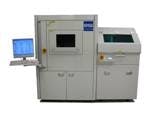ESI announces LED scribing, testing, and packaging systems
ESI has announced three new manufacturing-centric systems for the back end of the LED manufacturing process, and all three promise benefits for brighter, more-consistent solid-state lighting (SSL). The new products are the AccuScribe 2600 scribing system used in the wafer dicing process, the Model 5390 laser-based machining system used in packaging, and the Model 3800 tester that can automatically bin packaged LEDs.
ESI CEO Nick Konidaris noted the potential of the SSL market as a motivating factor for the development of the new manufacturing tools. Konidaris said, “LEDs is the fastest growing industry that we know today.”
Maintaining light extraction
The AccuScribe 2600 was designed to ensure that light-extraction techniques employed by LED makers are not impacted in the dicing process. Konidaris discussed the importance of brighter LEDs, saying “You need to have more lumens out for the same watt than you get from existing technologies. In fact, 10% more light output means 300% higher revenue for the manufacturer of the LED.”
Konidaris said that ESI developed the scribing system specifically based on customer requirements. LED makers have turned to Patterned Sapphire Substrates (PSS), Distributed Bragg Reflector (DBR), and Metal Mirror (MM) technologies to improve light extraction, maximizing photon output. According to Konidaris, many existing wafer dicing approaches can compromise the benefits of PSS, DBR, and MM. Konidaris said, “We enable a scribing process that maintains and enhances all of these [technologies].”
ESI believes that the AccuScribe system is unique in that it replaces multiple legacy systems. Konidaris said that today manufacturers must use separate tools to scribe the sapphire and metal layers.
The AccuScribe 2600 is currently undergoing qualification at multiple unnamed LED manufacturers. ESI expects to ship systems for revenue this year and the systems will sell in the $1.5 to $2 million range.
Laser drilled vias for packaging
In the packaging area, ESI has embarked on an alternative to the traditional approach of using bond wires to connect the LED anode and cathode to external contacts. Instead the Model 5390 tool uses a CO2 laser to drill vias in the LED die. The tool then electroplates the vias. The technique allows the machined die to be mounted on conductive posts.
Konidaris said the technique will enable longer LED life, smaller footprint packages, and higher current – and therefore brighter LEDs. The tool supports vias down to 60 microns in size and what Konidaris called “unparalled via placement accuracy.”
ESI has shipped one of the Model 5390 tools to an unnamed LED manufacturer and expects to ship systems for revenue later this year. The systems will sell in the $700,000 to $900,000 range.
Konidaris acknowledged that uptake on the system could be slow in the near term because the tool brings about a major change from the packaging technology in place today. But he also insists that the technology will deliver benefits especially in reliability. Konidaris said, “LEDs are good for tens of thousands of hours, but the packaging of LEDs may not be good for the same amount of time.”
Testing and binning
The Model 3800 tester targets production-scale testing of packaged LEDs. The system measures light output, light wavelength (color), and electrical characteristics and automatically sorts the components into as many as 512 bins. Binning is extremely important in the SSL space as lighting designers mandate consistent color in every luminaire or lamp.
The system uses a parallel architecture to process two LEDs simultaneously. Konidaris said the unit can test as many as 48,000 LEDs per hour. The company adopted technology proven in testers for multi-layer ceramic capacitors in developing the LED tester. The packaged LEDs ride in carriers throughout the testing process, and Konidaris said that design eliminates dropped or damaged components. The tool is configurable for any LED type.
The first of the Model 3800 testers is in the final stages at an unnamed LED manufacturer. That system only supports 256 bins. Again the company expects to ship systems for revenue this year with pricing will in the $400,000 range.







